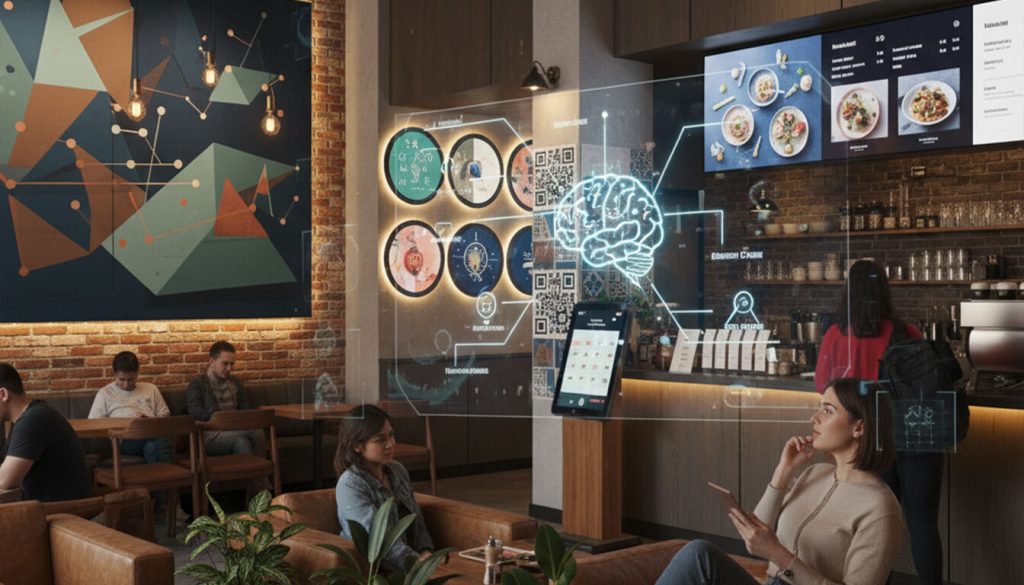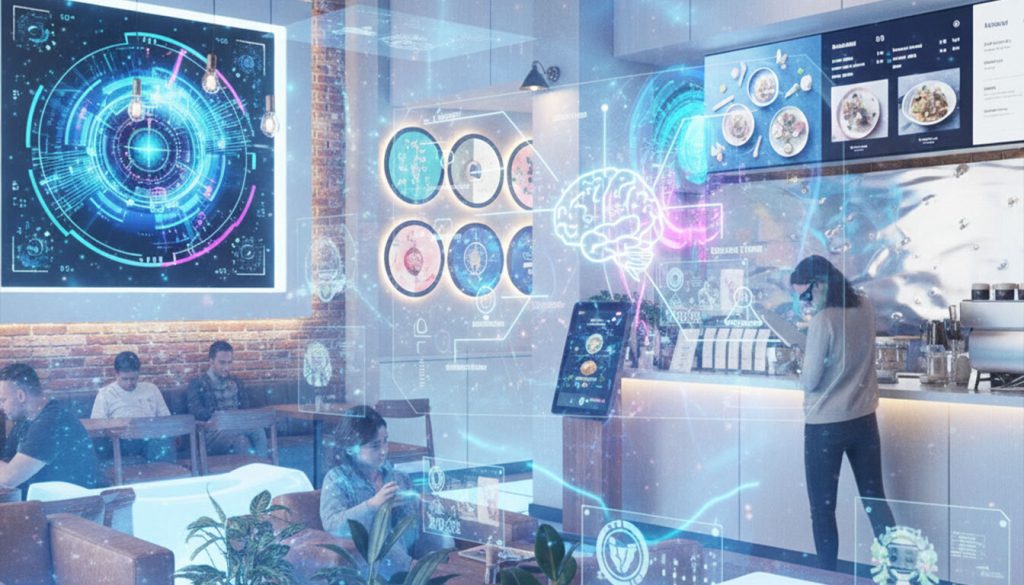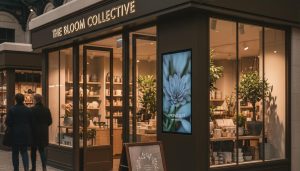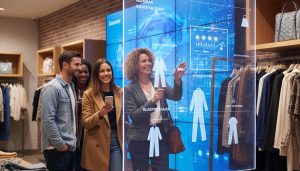Introduction
When customers walk into your office, showroom, or store, their first impression often determines how they perceive your brand. In today’s competitive market, smart indoor branding has become a game-changer for businesses aiming to build memorable, cohesive environments that reflect their values and vision.
Indoor branding goes far beyond a logo on the wall — it’s about creating a sensory experience through visual elements, materials, lighting, and layout. Whether you’re redesigning a corporate office or launching a retail store, your interior speaks volumes about your brand identity.
Msigns, a trusted name in indoor signage and branding solutions, specialises in turning ordinary interiors into extraordinary brand experiences.
What is Smart Indoor Branding?
Smart indoor branding is the strategic use of visual, physical, and digital elements inside a building to communicate a brand’s identity, story, and values. It’s about transforming physical spaces into immersive experiences that leave a lasting impression on visitors, clients, and employees alike.
This approach combines design, technology, and psychology to create environments that not only look beautiful but also align with a company’s goals. It goes beyond traditional signage — incorporating smart lighting, digital displays, branded textures, and interactive installations that make a space feel truly alive.
At its core, smart indoor branding ensures that every corner of your space reinforces your brand’s personality. From the reception desk to meeting rooms and corridors, it’s about maintaining consistency and clarity throughout.
Key Components of Smart Indoor Branding
- Visual Identity Integration – Using consistent colours, fonts, and materials that reflect your brand.
- Wayfinding and Signage Systems – Helping people navigate while subtly reinforcing brand presence.
- Interior Décor Alignment – Ensuring furniture, wall art, and lighting match the brand tone.
- Interactive and Digital Elements – Screens, smart displays, or augmented reality features for modern engagement.
- Employee and Customer Experience Design – Making the environment comfortable, inspiring, and memorable.
When done right, smart indoor branding doesn’t just decorate a space — it transforms it into a powerful communication tool.
The Importance of Smart Indoor Branding for Businesses
In today’s experience-driven marketplace, businesses are no longer just selling products or services — they’re selling environments and emotions. Smart indoor branding helps bridge that gap by creating a physical space that truly reflects your company’s essence.
It’s not just about putting your logo on walls or adding your brand colours to furniture; it’s about crafting an immersive environment that tells your story, connects with people, and influences perception.
Builds Stronger Brand Recognition
Every element in your interior — from lighting to signage — contributes to how people remember your brand. Consistent indoor branding ensures that customers instantly recognise your company’s identity, even before interacting with your products or services.
Enhances Customer Trust and Loyalty
A well-branded interior conveys professionalism and attention to detail. It shows that your business cares about presentation and experience, which fosters trust. When visitors walk into a space that feels cohesive and thoughtfully designed, they subconsciously associate your brand with reliability and quality.
Boosts Employee Morale and Productivity
Smart indoor branding isn’t just for customers — it’s also for your team. A workspace that embodies brand values makes employees feel connected and motivated. Visual consistency and inspiring design can significantly improve morale, creativity, and retention.
Creates Competitive Differentiation
In a crowded marketplace, standing out is crucial. Smart indoor branding gives you a unique edge — transforming your space into a visual signature that competitors can’t replicate. It becomes a physical manifestation of your brand’s values, culture, and story.
Supports Marketing and PR
Your interior space often appears in photos, videos, and digital campaigns. A well-branded environment naturally becomes a marketing asset, amplifying your message across online and offline channels.
Smart indoor branding isn’t a luxury — it’s a necessity for modern businesses aiming to leave lasting impressions and drive emotional connections.
Top 10+ Proven Strategies for Smart Indoor Branding Success
Implementing a successful smart indoor branding plan requires more than just visual appeal — it demands strategic thinking and consistency across every customer touchpoint. Below are more than ten proven strategies that businesses can use to transform their interior spaces into powerful branding environments.
Each of these methods aligns aesthetics with psychology, technology, and storytelling — the pillars of effective indoor branding.
1. Start with a Cohesive Brand Identity
Before designing or placing anything, ensure your brand identity is clearly defined. This includes your logo, colour palette, typography, tone of voice, and core message. These elements form the foundation for all indoor branding decisions.
When your interior space reflects your existing digital and visual identity, it strengthens recognition and creates a seamless experience for clients and visitors alike.
2. Use Smart Signage for Real-Time Engagement
Digital and LED signage are revolutionising smart indoor branding. Interactive displays, motion-triggered messages, and smart LEDs allow brands to communicate in real time.
From retail environments to offices and showrooms, dynamic signs can:
- Showcase current promotions or updates
- Highlight company milestones
- Engage visitors through motion graphics
Modern LED technology also allows energy-efficient and eco-friendly displays — perfectly blending innovation with sustainability.
3. Incorporate Environmental Storytelling
Your physical space should tell your brand’s story. Use design elements that reflect your history, mission, and achievements. For instance:
- A timeline wall showing your company’s growth
- Framed customer testimonials or media coverage
- Interactive digital boards featuring staff highlights
Story-driven interiors create emotional engagement and make the experience memorable.
4. Focus on Lighting Design
Lighting plays a crucial psychological role in how people perceive your brand. Soft, warm lighting promotes comfort and trust, while bright, clean lighting emphasises efficiency and transparency.
Smart lighting systems can automatically adjust brightness and colour to match your brand mood or specific zones — blending technology and design for maximum impact.
5. Create Branded Zones and Touchpoints
Divide your space into zones that represent various aspects of your brand. For example:
- Reception Area: First impression zone with logo displays and a branded welcome message
- Meeting Rooms: Incorporate subtle brand accents such as logo etching, colour palettes, or inspirational quotes
- Breakout Spaces: Use brand-inspired furniture and décor to encourage creativity
Each zone should tell a different part of your brand story while maintaining overall visual harmony.
6. Integrate Scent and Sound Branding
Smart indoor branding goes beyond visuals. Scent marketing — such as using a signature fragrance — can trigger emotional recall and brand recognition.
Similarly, curated soundscapes (soft music, ambient tones) enhance mood and align with your brand’s personality. Whether you’re a luxury retailer or a corporate office, these sensory cues strengthen engagement.
7. Prioritise Sustainability and Eco-Branding
Modern consumers value eco-conscious brands. Use sustainable materials — recycled wood, eco-friendly paints, and energy-efficient lighting — to reflect your commitment to the planet.
Sustainability isn’t just a trend; it’s a branding statement that communicates integrity and responsibility.
8. Harness Augmented Reality (AR) and Interactive Displays
AR technology allows customers or visitors to engage with your brand in unique ways. From product previews to digital tours, AR displays can make a lasting impact.
For offices, this can include digital name walls or client maps that light up interactively. For retailers, virtual try-ons or interactive catalogues enhance customer engagement.
9. Use Digital Wall Art and Motion Graphics
Static images are fading into the past. Incorporate motion graphics, animated LED walls, and projection mapping to create living, breathing environments.
Digital art not only captures attention but also provides flexibility — you can change campaigns, visuals, or messages instantly without reprinting materials.
10. Personalise the Visitor Experience
Smart indoor branding also means using data and automation to personalise experiences. For instance:
- Digital kiosks that greet repeat customers by name
- Smart screens showing tailored content
- AI-driven lighting or temperature preferences for employees
Personalisation shows attention to detail and builds strong emotional connections.
11. Train Staff as Brand Ambassadors
Your staff are the living embodiment of your brand. Train them to understand and reflect your visual identity, tone, and customer experience principles.
When your team aligns with your brand’s indoor environment, it reinforces authenticity and ensures consistency across every interaction.
Technological Innovations Powering Smart Indoor Branding in 2025
The future of smart indoor branding lies in technology — where design, data, and digital experiences converge to create seamless and powerful brand interactions.
In 2025, businesses are no longer limited to static décor or traditional signage. Instead, they are embracing innovative technologies that respond, adapt, and evolve with customer needs and moods.
Below are some of the most exciting technological innovations transforming indoor branding today.
1. Internet of Things (IoT) Integration
The Internet of Things allows devices within your branded environment to communicate with each other. For instance:
- Smart displays that update automatically based on time or audience behaviour
- Temperature and lighting systems that adjust to customer flow
- Digital screens that track dwell time to optimise content
IoT-driven branding creates dynamic, data-backed spaces that adapt intelligently to real-time conditions — enhancing engagement and reducing energy costs.
2. AI-Powered Customer Analytics
AI is at the heart of smart indoor branding in 2025. Artificial intelligence can analyse customer movements, preferences, and interactions within physical spaces.
Retailers and offices use AI analytics to:
- Identify which areas attract the most attention
- Determine which displays or signage drive engagement
- Optimise layout and messaging for maximum impact
This helps brands refine both design and communication strategies for a higher ROI on physical marketing.
3. LED and OLED Display Advancements
LED technology continues to evolve rapidly, making it a central pillar of outdoor and indoor branding. Modern LED and OLED panels are thinner, more energy-efficient, and capable of displaying ultra-high-resolution visuals with minimal glare.
Benefits include:
- Vivid colour accuracy for brand consistency
- Seamless integration into walls or furniture
- Smart control via Wi-Fi or remote systems
For brands like Msigns, integrating these technologies ensures flexible and sustainable indoor signage that can easily adapt to campaigns or seasons.
4. Smart Mirrors and Interactive Touchscreens
Retailers and service providers are increasingly using interactive touchpoints such as digital mirrors, touchscreen directories, and interactive walls.
For example:
- Smart Mirrors in clothing stores can display outfit suggestions or colour variants.
- Touch Displays in corporate lobbies can feature staff directories, service options, or event schedules.
These innovations not only modernise customer interaction but also extend brand storytelling through technology.
5. Projection Mapping and Immersive Visuals
Projection mapping allows any surface — a wall, floor, or product — to become a live digital display. Using light and motion, brands can transform plain environments into interactive and cinematic experiences.
Imagine walking into a hotel lobby where the walls react to your movements, or a product launch where visuals morph as the presenter speaks — this is branding through immersion.
6. Virtual Reality (VR) and Augmented Reality (AR)
VR and AR technologies enable customers to experience brands beyond physical limits.
Examples include:
- AR Apps: Let customers visualise signage, furniture, or installations before purchase.
- VR Tours: Offer virtual walkthroughs of branded environments, useful for property developers, universities, or showrooms.
These tools combine convenience with creativity — giving smart indoor branding a futuristic dimension that engages both physically and digitally.
7. Voice-Activated Brand Interfaces
Voice technology isn’t just for smartphones or smart homes anymore. In branded spaces, voice assistants can:
- Welcome visitors to offices
- Provide directions or information
- Deliver custom brand messages based on user prompts
This hands-free, accessible technology improves customer comfort while reinforcing brand sophistication.
8. AI-Personalised Digital Signage
AI-driven signage systems adapt to viewer demographics or behaviours in real-time. For example, sensors can detect age group or gender to tailor content — such as personalised offers, product recommendations, or language adjustments.
This approach ensures maximum message relevance, enhancing customer satisfaction while demonstrating technological leadership.
9. Smart Lighting with Brand Integration
Dynamic lighting systems now play a key role in smart indoor branding.
By integrating with digital platforms, lighting can:
- Change colours based on brand events or holidays
- React to sound or motion for interactive experiences
- Enhance focus zones in offices or highlight displays in stores
Smart lighting also supports sustainability, using automation to minimise energy use while maintaining aesthetic appeal.
10. NFC and QR-Based Engagement
Quick Response (QR) codes and Near Field Communication (NFC) devices bridge physical branding and digital content.
Customers can:
- Scan QR codes on wall graphics to access videos, offers, or reviews
- Tap NFC tags to connect to apps or loyalty programs
- Engage with brand content instantly without human interaction
This phygital experience (physical + digital) strengthens convenience and creates measurable data for marketing insights.
11. Cloud-Based Display Management
Managing multiple digital screens across different branches or floors has never been easier.
Cloud-based management platforms allow brands to:
- Update content remotely
- Schedule brand campaigns
- Ensure brand consistency across locations
This is particularly beneficial for franchises and corporate offices maintaining uniform branding standards globally.
The Role of Design Psychology in Smart Indoor Branding

To truly master smart indoor branding, understanding human psychology is essential. Every colour, shape, light intensity, and layout design influences how people feel, behave, and remember your brand. This connection between space and emotion is what separates good branding from unforgettable branding.
In 2025, businesses are leveraging design psychology to craft experiences that not only attract attention but also encourage engagement, comfort, and loyalty. Let’s explore how psychology drives success in smart indoor branding.
The Power of Colour Psychology
Colours aren’t just aesthetic choices — they’re emotional triggers.
Each colour evokes a specific mood or perception that can be used to reinforce your brand’s personality.
- Blue evokes trust and calm, ideal for corporate or healthcare settings.
- Red creates energy and urgency, perfect for retail or entertainment.
- Green symbolises growth and harmony, fitting for eco-friendly or wellness brands.
- Yellow inspires optimism and creativity, ideal for modern offices or start-ups.
By aligning colours with your brand values, you create a subconscious emotional link that strengthens recognition and loyalty.
Spatial Flow and Movement Psychology
Smart indoor branding goes beyond static design. The way people move through your space — known as spatial flow — affects how they experience your brand.
For example:
- A clear pathway through a store ensures customers engage with key displays.
- Open layouts foster comfort and transparency, ideal for collaborative environments.
- Structured zones help people focus, making corporate areas more productive.
Using design psychology to manage spatial flow ensures visitors feel guided, not confused — enhancing both functionality and brand impact.
Sensory Branding: Engaging Beyond Sight
Smart indoor branding isn’t only about what people see. Multisensory design — engaging sound, touch, and even scent — creates deeper emotional experiences.
- Sound Design: Background music that reflects your brand’s tone (calm for clinics, upbeat for retail).
- Texture and Touch: Branded materials like brushed metal or velvet that evoke quality and comfort.
- Scent Branding: Distinct fragrances that trigger brand recall and improve visitor mood.
When all senses align under one brand message, it produces a cohesive and memorable brand experience that stays with people long after they’ve left.
Lighting Psychology and Mood Creation
Light affects focus, comfort, and mood. Smart lighting systems — a key part of smart indoor branding — allow businesses to adjust brightness and warmth dynamically.
- Cool lighting promotes focus and productivity in workspaces.
- Warm lighting creates comfort in lounges, restaurants, or waiting areas.
- Accent lighting highlights brand features like logos or statement walls.
Properly designed lighting not only improves visibility but also enhances emotional connection and spatial perception.
The Power of First Impressions
The entrance or reception area is often the first and most lasting point of contact with your brand. Through design psychology, businesses can ensure this space:
- Evokes confidence and professionalism.
- Reinforces brand identity through visual storytelling.
- Guides visitors intuitively towards the next area of interaction.
For example, a digital welcome screen that greets clients by name or a feature wall displaying brand milestones can leave a powerful emotional mark.
Cognitive Load and Minimalism
In branding, less is often more. Spaces cluttered with too many visuals, signs, or messages can overwhelm the brain — reducing attention and retention.
Modern smart indoor branding focuses on clarity, spacing, and simplicity, ensuring every element serves a purpose. This design discipline not only makes spaces aesthetically pleasing but also improves message clarity and cognitive comfort.
Consistency Equals Trust
Consistency builds familiarity — and familiarity breeds trust.
From signage typography to wall art, using consistent branding elements across all physical spaces strengthens brand reliability and recognition.
Design psychology supports this by ensuring the same emotional tone is carried throughout — whether a customer enters your lobby, office, or meeting room.
10+ Proven Strategies to Unleash the Power of Smart Indoor Branding
Smart indoor branding isn’t just about visuals — it’s about creating an immersive, functional, and emotionally engaging environment that embodies your brand’s identity. In 2025, businesses across the UK are elevating their branding strategies by blending creativity, technology, and psychology.
Here are more than ten proven strategies that help you unlock the full potential of smart indoor branding.
1. Start with a Clear Brand Identity
Before you can design your space, you must understand what your brand stands for.
Ask yourself:
- What emotions should people feel when they enter your premises?
- What message do you want the space to communicate?
- How can your physical environment support your company’s goals?
Your indoor branding should reflect your brand promise and values — from colour palettes to furniture choices. Every design decision should be intentional.
2. Map the Customer Journey Within Your Space
Smart indoor branding starts with mapping how people move through your environment.
- Identify key touchpoints such as entrances, waiting areas, service counters, and exits.
- Ensure brand messages or visuals appear at crucial decision points.
- Use lighting, layout, and signage to guide flow and behaviour naturally.
This ensures that your visitors interact with your brand story in a logical and emotionally engaging sequence.
3. Integrate Digital Signage Strategically
Digital signage is at the heart of smart indoor branding innovation.
Use it for:
- Welcoming visitors with personalised greetings.
- Displaying real-time promotions, social feeds, or company news.
- Creating dynamic ambience through motion graphics or video walls.
With remote management, digital signs can be updated instantly to keep your branding relevant and fresh.
4. Blend Physical and Digital Experiences (“Phygital” Branding)
Phygital branding merges physical environments with digital experiences.
For example:
- Use QR codes or NFC tags to link wall art to videos or brand stories.
- Add interactive kiosks that help customers explore your services.
- Encourage visitors to share branded spaces online, boosting visibility organically.
This integration ensures that your physical branding extends seamlessly into your digital ecosystem.
5. Highlight Your Core Values Through Design Elements
Each space in your environment should subtly echo your brand’s core values.
- A sustainability-focused company might use recycled materials, green walls, or natural lighting.
- A tech-driven business could showcase transparent glass designs, LED displays, and smart workstations.
Every visual cue reinforces brand credibility — without needing words.
6. Prioritise Wayfinding and Clarity
One hallmark of professional indoor branding is intuitive navigation.
Your signage, layout, and visual cues should naturally lead people to their destination.
- Use colour-coded zones for large facilities.
- Include consistent typography and iconography across all directional signs.
- Combine design and utility — wayfinding can be aesthetic and functional.
A well-organised space reflects a well-organised brand.
7. Use Lighting as a Branding Tool
Lighting does far more than illuminate a space — it sets tone and mood.
Smart lighting systems can:
- Change colour based on time of day or event themes.
- Highlight feature areas such as brand logos or product displays.
- Adjust automatically for energy efficiency and comfort.
Lighting reinforces your brand’s personality — vibrant for modern brands, calm and subtle for luxury ones.
8. Leverage Sustainable and Eco-Friendly Materials
Sustainability is now a core part of smart indoor branding. Using eco-friendly materials communicates social responsibility and modernity.
Consider:
- Bamboo, reclaimed wood, and low-VOC paints.
- Energy-efficient LED systems and smart climate controls.
- Biophilic design elements like live plants or natural textures.
Such elements promote wellbeing while showcasing your commitment to the planet — a message that resonates strongly with modern audiences.
9. Personalise Your Workspace Experience
Smart branding is personal. Use technology and design to create experiences that feel tailored and meaningful.
- Display team achievements on digital walls.
- Personalise meeting room names to reflect company values.
- Use scent branding or ambient music that matches your tone of voice.
Personalisation builds emotional connections and makes the brand more relatable.
10. Keep Branding Consistent Across All Touchpoints
Consistency across all elements — print, digital, and physical — reinforces credibility and memorability.
That means:
- Matching fonts and colours to digital branding.
- Using the same tone and messaging style everywhere.
- Ensuring your indoor space aligns with your website and social media visuals.
When consistency is maintained, your brand feels trustworthy and professional.
11. Include Interactive Experiences
Encourage engagement through interactive installations that allow visitors to touch, explore, or play.
Examples include:
- Motion-sensitive walls that react to movement.
- Product displays that activate through proximity sensors.
- Digital mirrors for virtual product trials.
These experiences stimulate curiosity and build memorable associations with your brand.
12. Measure and Optimise Performance
Smart indoor branding doesn’t end with installation. Use analytics and feedback tools to monitor performance.
- Track visitor movements via IoT sensors.
- Measure dwell times and engagement levels.
- Collect feedback on comfort, navigation, and visual appeal.
This data helps you refine the experience continuously — keeping your brand environment effective and engaging.
Future Trends in Smart Indoor Branding (2025 and Beyond)

As we move deeper into 2025 and beyond, smart indoor branding is becoming more intuitive, data-driven, and experience-centred. The convergence of design, technology, and psychology will redefine how brands shape customer experiences inside physical spaces. Below are the key trends driving this transformation.
AI-Powered Personalisation
Artificial Intelligence is revolutionising how brands interact with their visitors. By analysing behaviour, demographics, and preferences, AI enables real-time personalisation of indoor environments.
- Example: A retail store can automatically adjust display content based on customer age groups or time of day.
- Result: Enhanced engagement and stronger emotional resonance, as every visitor feels uniquely acknowledged.
Key takeaway: Personalised brand environments foster loyalty and make your indoor branding feel intelligent rather than static.
Sustainable and Circular Design
Eco-consciousness is now a core expectation among UK consumers. Smart indoor branding will continue prioritising sustainability through:
- Recyclable and low-impact materials
- Modular fixtures that can be reused across campaigns
- Energy-efficient lighting systems
Brands that combine sustainability with smart functionality not only appeal to ethical consumers but also enhance long-term cost efficiency.
Mixed Reality Experiences
Augmented Reality (AR) and Virtual Reality (VR) are increasingly becoming part of interior brand storytelling.
- Retail example: Customers can visualise how furniture will look in their homes using AR.
- Corporate example: Visitors can explore company milestones in immersive VR installations.
Smart indoor branding in 2025 will merge physical and virtual dimensions — creating a hybrid engagement model that extends beyond the walls.
Emotion-Driven Environments
Brands are realising that emotions, not just visuals, define customer loyalty. Using ambient lighting, scent diffusion, and acoustics, indoor spaces are now designed to evoke specific feelings — calm, excitement, or inspiration — depending on brand goals.
This emotional branding through sensory design creates stronger connections and reinforces brand perception subconsciously.
Data-Integrated Branding Systems
With the growth of smart sensors, AI analytics, and IoT, every branding element can now generate actionable insights.
- Footfall trends reveal which branding areas attract the most engagement.
- Sensor-based analytics show which interactive displays convert best.
- Data dashboards help brand managers make evidence-based improvements.
This feedback loop turns branding into an evolving ecosystem rather than a one-time investment.
Adaptive Branding Spaces
Static branding is fading away. Smart indoor environments now adapt in real time based on context.
- A café might switch its lighting and visuals for different times of the day.
- An office reception could display tailored messages for specific clients visiting.
- Retail stores can adjust displays dynamically based on sales or promotions.
This trend ensures maximum relevance, making every visit feel intentional and personalised.
Human-Centred Design in Smart Branding
Despite technological advancement, the human experience remains central. Smart indoor branding is shifting towards inclusivity — considering accessibility, comfort, and well-being.
- Accessible design: Clear wayfinding, tactile surfaces, and visual contrast.
- Comfort features: Air quality monitoring, ergonomic furniture, and noise control.
- Well-being design: Integrating greenery and natural light to promote calmness.
The future of smart indoor branding isn’t just digital — it’s deeply human.
Multi-Sensory Storytelling
The next era of branding goes beyond sight. Successful smart environments engage all five senses — combining visuals, textures, sounds, scents, and even taste (in hospitality and retail).
This layered storytelling approach helps brands form deeper emotional associations, increasing recall and differentiation in saturated markets. But sensory impact means little without long-term visibility — especially in physical spaces. Durable, well-designed signage plays a critical role in maintaining brand presence and consistency. Learn more in our blog: The Importance of Durability in Custom Sign Design.
Brand Consistency Across Hybrid Spaces
As businesses operate in both physical and digital realms, ensuring a seamless identity across channels is vital.
Smart branding ensures that in-store experiences match the digital tone — same colour palette, typography, and emotional energy.
This omnichannel consistency strengthens trust and reinforces brand familiarity wherever customers engage.
Integration with Smart Cities
Looking beyond 2025, indoor branding will connect to urban smart systems — sharing data with transportation hubs, event venues, and shopping districts.
For instance, a brand could adjust its indoor advertisements based on nearby traffic or local events, creating truly contextual branding experiences.
This synergy between smart indoor branding and smart urban design will redefine how brands participate in public life.
Final Thoughts: The Future Belongs to Adaptive, Intelligent Branding
In an increasingly competitive marketplace, smart indoor branding is no longer a luxury — it’s a strategic necessity.
It bridges the gap between technology and emotion, creating brand environments that are not only visually stunning but also purposeful, data-informed, and human-centric.
To summarise the key pillars of success:
- Define your brand DNA before designing your physical space.
- Leverage technology (IoT, AI, and AR) for interactivity and personalisation.
- Invest in sustainability for ethical credibility and cost efficiency.
- Measure performance through data and continuously optimise your strategy.
- Design for emotion — because connection, not just recognition, drives loyalty.
At Msigns, we help businesses transform their interiors into intelligent storytelling platforms — combining design innovation with strategic thinking to ensure your space doesn’t just look good, but works for your brand.

















